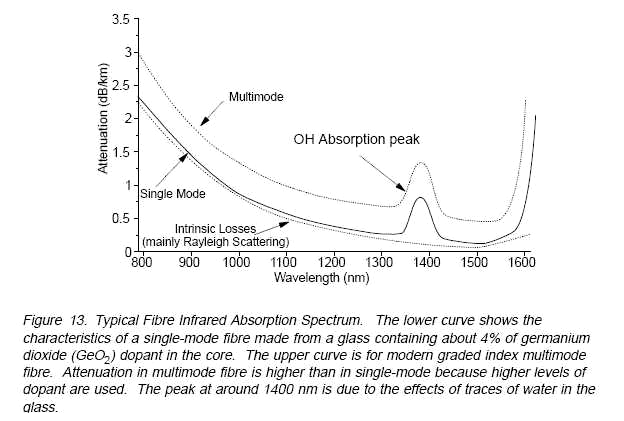In “the good old days” some things in the world of fiber optics were very, very difficult: fibers were often manufactured with very poor control over physical geometry, impurity levels and doping profiles so that they were usually quite lossy, had poor bandwidths and connector and splice losses were sometimes 2 to 3dB and not very consistent. In addition, it was all very expensive; even more so with singlemode fibers.
However, one good thing for quite a few years was that in the world of data communications applications where almost everyone used multimode fiber they also operated at an optical wavelength of around 800 to 880nm. Likewise, in the rarefied atmosphere of telecommunications, everyone there used singlemode fiber which was almost always operated at 1310nm over distances of up to 50 ~ 100km and at 1550nm for longer distances.
Nice and simple. In fact, so nice and simple that people started to associate multimode fiber with 850nm and singlemode with 1310nm or 1550nm and this is today still a very common belief.
In reality, it is quite possible to transmit 1310nm or 1550nm over multimode fiber and this is, in fact, very commonly done. However, perhaps surprisingly, it is also possible to transmit 850nm over singlemode fiber. Modern singlemode fiber has very low attenuation at 850nm as shown in the sketch below:
 At 850nm a good multimode fiber will have around 2.5dB/km and a good singlemode fiber will have about 1.8dB/km. There are two main reasons we don’t normally operate singlemode fibers at 850nm:
At 850nm a good multimode fiber will have around 2.5dB/km and a good singlemode fiber will have about 1.8dB/km. There are two main reasons we don’t normally operate singlemode fibers at 850nm:
- Typical sources such as LEDs or VCSELs generally can’t couple a lot of power into the fiber so the use of 850nm would be restricted to quite low speed links because such links generally employ sensitive optical receivers.
- When operating much below 1250nm standard singlemode fibers start operating like multimode fibers so there are several modes capable of propagating through the fiber. Since most singlemode fibers have a step index refractive index profile this means that the bandwidth is very poor, typically 5~10MHz.km: not much good for high speed data.
Despite these limitations, it is still sometimes OK to operate so-called multimode equipment over singlemode fiber. For example, Optical Systems Design has occasionally connected up its 850nm multimode modems such as E1 PCM terminals and low speed industrial modems to singlemode fiber when singlemode was all that was available. While not an ideal solution, it can be very practical and technically safe in some situations and is worth considering if you are, as they say, between a rock and a hard place. Feel free to call us for advice, even if the equipment isn’t ours!
It may be apparent that if we can send one data signal over a fiber at one wavelength, we should be able to send many such signals if we can employ multiple wavelengths. The telecommunications sector has been using such techniques for many years with some systems in operation carrying well over 100 separate 2.5G or 10Gbps signals each on its own unique wavelength and with all of them on the one fiber.
Simplified, more rugged and lower cost versions of these systems have been finding their way into areas such as transportation, security and many other industrial/commercial applications over the past several years. We look at this in a little more detail in other Tech Notes.




